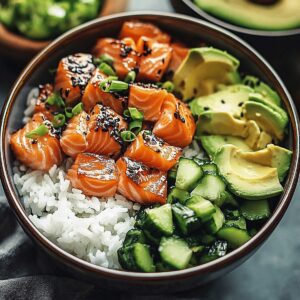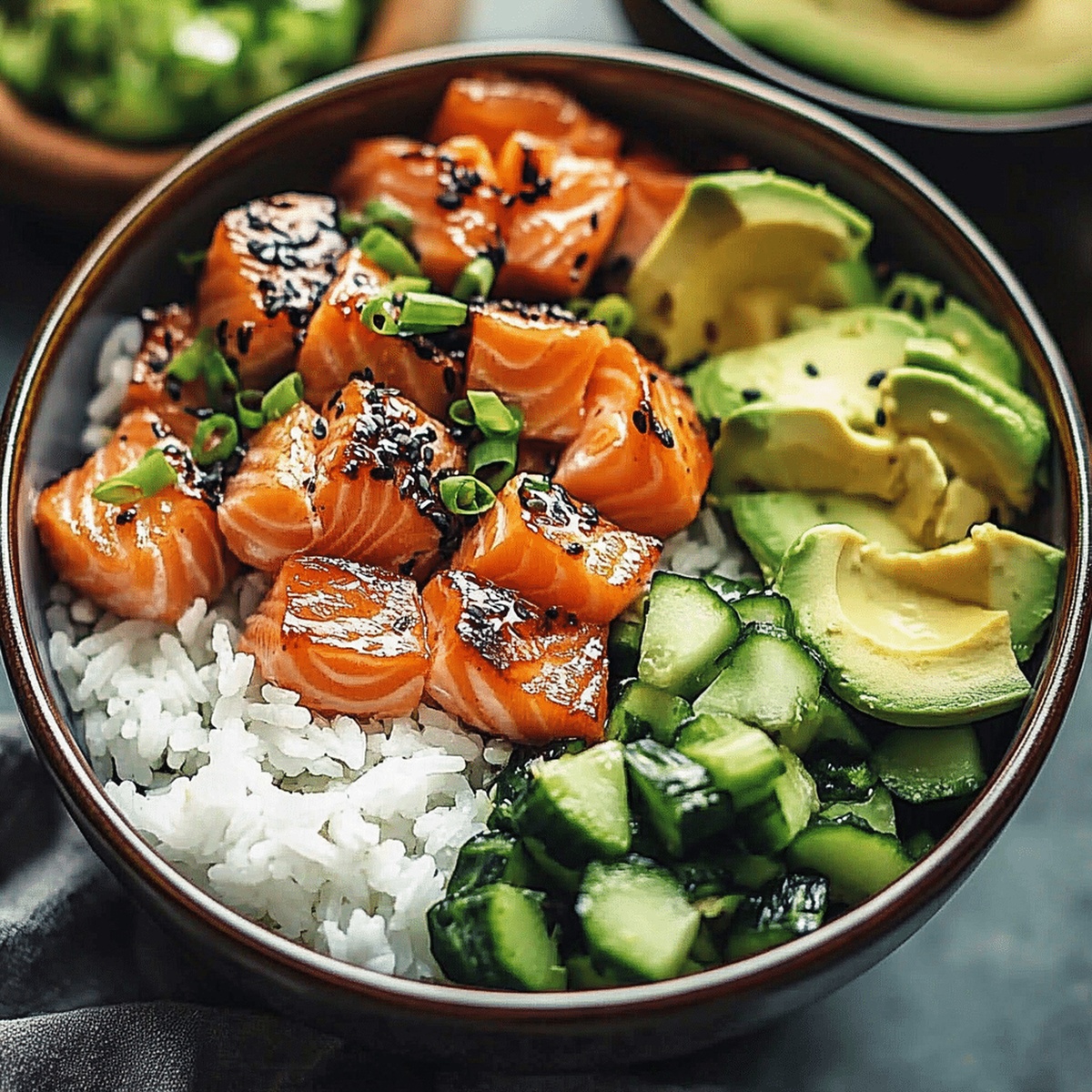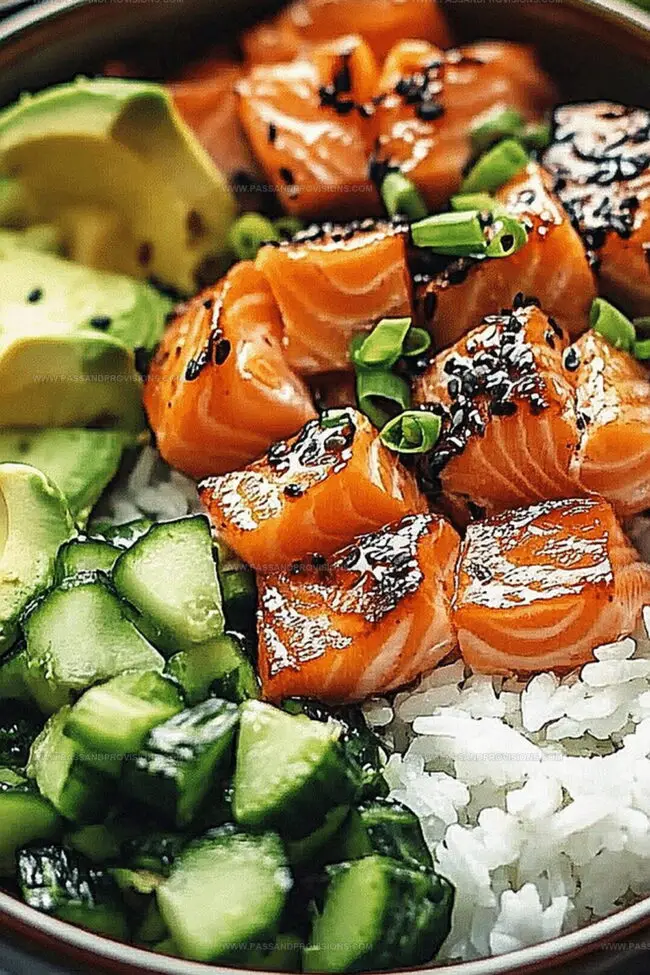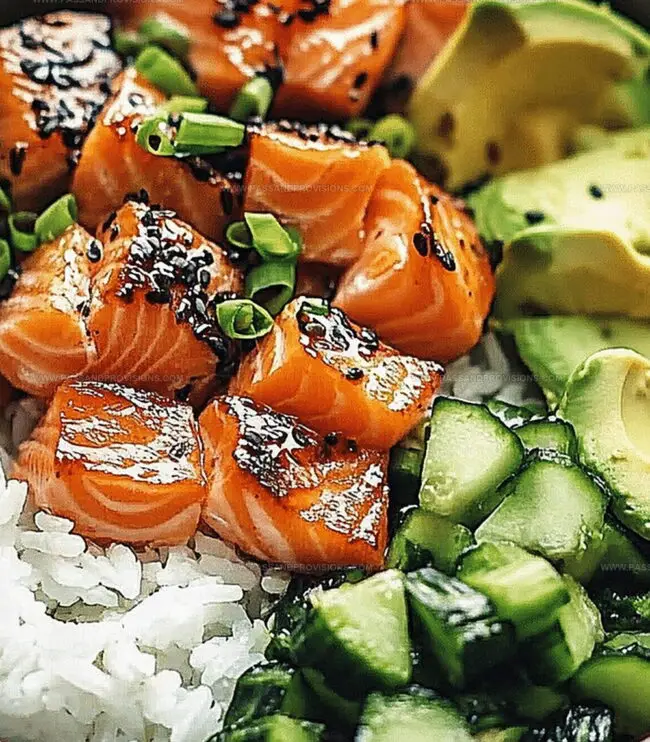Salmon Rice Bowls Recipe for Cozy Dinner Success
Crisp coastal winds whisper memories of my salmon rice bowls dancing with vibrant flavors and unexpected textures.
Pacific Northwest ingredients weave magic into each carefully crafted bite.
Fresh ingredients matter most when creating this simple yet stunning meal.
Delicate salmon pieces nestle atop perfectly steamed grains, creating a harmonious canvas.
Mediterranean and Asian influences merge seamlessly in this quick weeknight dinner solution.
Colorful vegetables add crunch and brightness to every delightful spoonful.
Let’s unpack the secrets behind making this irresistible bowl that’ll have you returning for seconds.
What Makes Salmon Rice Bowls a Must-Try Meal
What You’ll Need for Salmon Rice Bowls
Main Ingredients:
Protein:Starches:Vegetables:Sauce Components:Aromatics and Seasonings:Spices and Heat:Garnish:Cooking Directions for Flavorful Salmon Bowls
Step 1: Prepare Zesty Marinade
Whisk together in a mixing bowl:Step 2: Marinate Salmon
Coat salmon fillets generously in the marinade and let them soak for 10-15 minutes at room temperature.
Step 3: Sear Salmon To Perfection
Heat skillet over medium-high flame and cook salmon 3-4 minutes per side until golden and fully cooked.
Step 4: Create Tangy Drizzle Sauce
Whisk together in a small bowl:Step 5: Assemble Rice Bowls
Divide warm rice into serving bowls and layer with:Step 6: Finish And Garnish
Drizzle bowls with prepared sauce and sprinkle with:Serve immediately and savor your homemade culinary creation.
Tips for Making the Best Salmon Rice Bowls
Leftover Storage for Salmon Rice Bowls
What Goes Well with Salmon Rice Bowls
Salmon Bowl Variations to Explore
Salmon Rice Bowls FAQs
Yes, thaw frozen salmon completely before marinating and cooking to ensure even cooking and best flavor absorption.
Check that the salmon reaches an internal temperature of 145°F and flakes easily with a fork. The fish should be opaque and light pink throughout.
You can use a mild-flavored olive oil or grapeseed oil, though sesame oil adds a distinctive nutty flavor that enhances the dish.
Add extra red pepper flakes to the marinade or increase the amount of sriracha in the soy-ginger sauce to boost the heat level to your preference.
Print
Salmon Rice Bowls Recipe
- Total Time: 20 minutes
- Yield: 4 1x
Description
Delightful salmon rice bowls bring Mediterranean flavors to your dinner table with minimal effort. Fresh salmon nestled on fragrant rice creates a quick, nutritious meal that satisfies and delights.
Ingredients
Main Protein:
- 4 salmon fillets (about 56 ounces / 1.6 kilograms each)
Protein Marinades and Seasonings:
- 1 tablespoon olive oil
- 1 tablespoon soy sauce
- 1 tablespoon honey or maple syrup
- 1 teaspoon sesame oil
- 2 cloves garlic, minced
- 1 teaspoon grated ginger
- ½ teaspoon black pepper
- ½ teaspoon salt
- ½ teaspoon red pepper flakes (optional)
Base and Vegetables:
- 2 cups cooked jasmine or brown rice
- 1 cup shredded carrots
- 1 cup cucumber, thinly sliced
- 1 avocado, sliced
- ½ cup edamame (optional)
Garnish and Sauce Ingredients:
- 2 tablespoons green onions, chopped
- 1 tablespoon sesame seeds
Sauce Ingredients:
- ¼ cup soy sauce
- 1 tablespoon honey or brown sugar
- 1 tablespoon rice vinegar
- 1 teaspoon sesame oil
- 1 teaspoon grated ginger
- 1 teaspoon sriracha (optional, for spice)
Instructions
- Prepare a flavorful marinade by whisking olive oil, soy sauce, honey, sesame oil, minced garlic, grated ginger, salt, black pepper, and red pepper flakes in a mixing bowl.
- Generously coat salmon fillets with the prepared marinade, allowing them to absorb the flavors for 10-15 minutes at room temperature.
- Preheat a skillet over medium-high heat with a touch of oil to prevent sticking.
- Carefully place marinated salmon in the hot skillet, cooking each side for 3-4 minutes until a golden crust forms and the fish is cooked through.
- Create a complementary sauce by combining soy sauce, honey, rice vinegar, sesame oil, ginger, and sriracha in a small bowl, whisking until well blended.
- Distribute warm, fluffy rice evenly among serving bowls as the base.
- Gently place the perfectly cooked salmon on top of the rice.
- Artfully arrange shredded carrots, crisp cucumber slices, creamy avocado chunks, and vibrant edamame around the salmon.
- Drizzle the prepared soy-ginger sauce over the bowl, ensuring each ingredient gets a light coating.
- Finish by sprinkling chopped green onions and a generous scatter of sesame seeds for added texture and flavor.
- Serve immediately while still warm, allowing the aromatic ingredients to tantalize the senses.
Notes
- Marinate salmon briefly to infuse maximum flavor without breaking down the delicate fish proteins.
- Adjust heat carefully when cooking salmon to prevent overcooking, which can make the fish dry and tough.
- Swap salmon for tofu or chickpeas to create a vegetarian-friendly version that maintains the bowl’s vibrant profile.
- Use short-grain or brown rice as a nutritious alternative to white rice, boosting the bowl’s fiber and mineral content.
- Prep Time: 10 minutes
- Cook Time: 10 minutes
- Category: Lunch, Dinner
- Method: Frying
- Cuisine: Japanese
Nutrition
- Serving Size: 4
- Calories: 635
- Sugar: 12 g
- Sodium: 900 mg
- Fat: 30 g
- Saturated Fat: 4 g
- Unsaturated Fat: 22 g
- Trans Fat: 0 g
- Carbohydrates: 66 g
- Fiber: 6 g
- Protein: 32 g
- Cholesterol: 70 mg




Jamie Granger
Recipe Developer & Food Writer
Expertise
Education
Culinary Institute of America
Jamie Granger turns ingredients into memories. With her recipes, she brings a fusion-forward flair to every creation.
Her dishes reflect the places she’s explored, the chefs she’s learned from, and the deep connection she has to food as a form of expression.
At Pass and Provision, Jamie develops recipes that balance flavor, health, and beauty, meals that don’t just satisfy your appetite but speak to your curiosity.